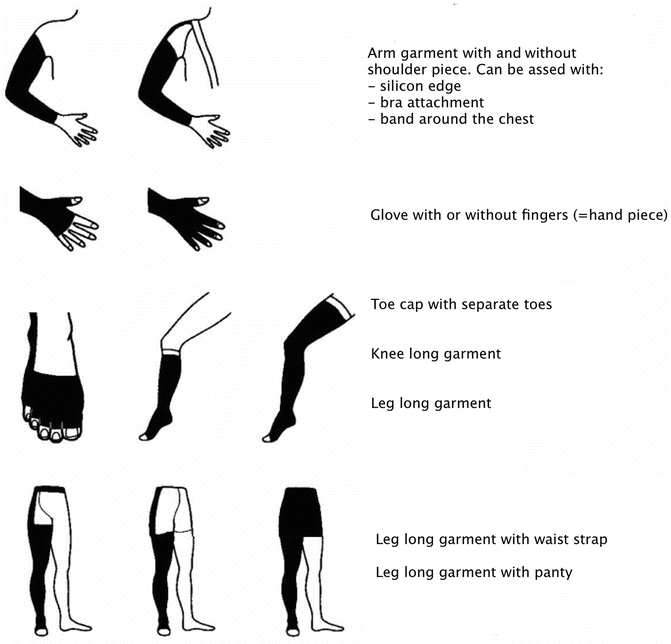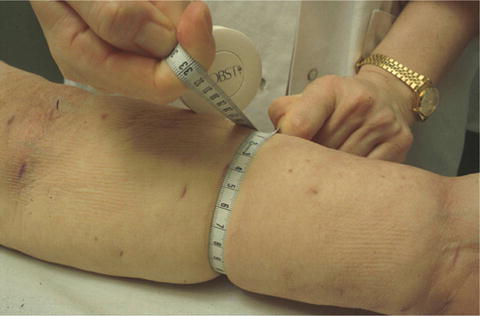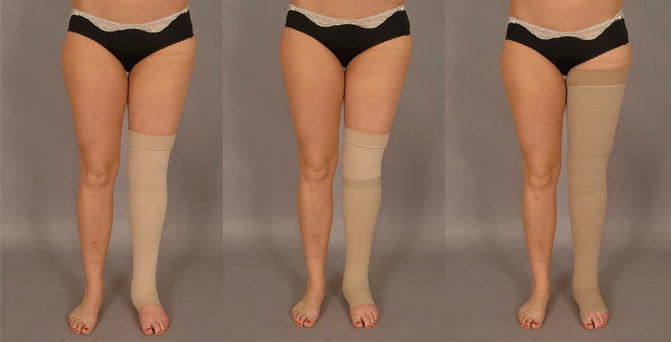CCL I:
Mild
15–21
mmHga
CCL II:
Moderate
23–32
mmHg
CCL III:
Strong
34–46
mmHg
CCL IV:
Very strong
49–
mmHg
Compression garments for the arm and hand are usually ordered in CCL 2. When only incipient symptoms are present, CCL 1 can be sufficient. Garments for the leg often require CCL 3 or more. If the lymphedema requires higher compression a combination with an additional garment on top on the first one can be used. This increases the compression further and can be easier to put on than just one garment in very high compression class. In severe cases another leg long garment may be needed, either round knitted or flat knitted.
Material
Materials and production methods vary between different manufacturers. There are circular knitted garments without a seam and flat knitted with a seam. The higher compression classes are usually flat knitted. It should be noted that each class is within a compression interval, and within the compression class different materials may have higher or lower compression. Verify how long the manufacturer guarantees that the garment lasts for the specified compression. Garments in softer materials have a shorter durability and must be replaced more often, even though the compression is the same as that of a more rigid garment.
Patients with sensitive skin may need to try different brands. If the patient encounters irritation at the elbow or at the back of the knee, a soft lining can be sewn into the sock. There are also modifications in the knitting technique that decreases skin irritation at these locations. There are also different brands of silicone or hydrogel plates, to be put under the garment that will relieve irritated skin.
Size
Compression stockings are produced in different standard sizes or made to measure.
Standard size garments—advantage
The patient receives the garment at once
Measuring is simpler
Standard Size Garments: Disadvantage
Do not have enough widths and lengths to suit all
Smaller selection of materials
Smaller selection of models
Made to Measure Garments: Advantages
Optimal fit
Greater possibility when remeasuring in order to gradually reduce the size of the garment as the edema is reduced
Made to Measure Garments: Disadvantages
More extensive measuring
Delivery time
The cost
If made to measure is selected after treatment, the patient must either use a standard garment or bandage the extremity until the custom-made garment has been delivered. Later on, when measuring for the next garment the measurements must be compared with the previous order to check that the garment gives the intended effect. The technique when measuring varies from brand to brand. See the instructions of each manufacturer.
Design
Compression stockings are available in various models (Fig. 18.1). You can also choose various fasteners, such as silicone ribbon at the top of the garment or a band around the waist. Each manufacturer provides information about the different varieties available. Which one you choose depends on:


Fig. 18.1
Compression garments are available in various models. © Karin Ohlin
Edema location
The patient’s body constitution
The patient’s wishes
How compression stocking works in daily activities
Taking On and Off the Garment and Maintenance of the Garment
Check that the patient can maintain and manage to take on and off the garment. If the patient has problems one must arrange for someone to help out, such as a relative or home care/district nurse, who also may need instructions. At follow-up, check that this has worked. The manufacturers provide different types of aids that facilitate the procedure.
Use
The various alternatives depend on the severity of the edema:
Continuously throughout the day
Continuously during daytime (the garment must be taken on in the morning)
Only use it when performing strenuous labor (prolonged static or heavy work, where patients experience that the extremity gets swollen) and at long journeys by plane or car
After a few weeks, it is important to verify that compression stockings have the intended effect. Rash after use may be due to an allergic reaction to detergents, or to the garment material, which is very uncommon. If the excess volume has increased at follow-up, this can be due to several factors:
Bad patient compliance; check the patient’s motivation and every day routines
The patient has not understood how the garment must be taken care of or has taken it on in the wrong way (for example not pulled it high enough)
Incorrect measurements have been taken—check them
Insufficient compression class—increase compression class at the next order
Progress of underlying malignancy
Costs
The life span of a compression garment varies between 3 and 6 months, provided that the patient has two garments to switch between. Two garments are required so that the patient every day can take on a newly washed garment. At the first time only one garment is ordered to evaluate the fit and to be able to make any corrections. Then the second garment is promptly ordered. Henceforth two garments should be ordered at each occasion. The minimum amount of compression garments for an arm lymphedema is two every 6 months. If gloves/gauntlets are needed, 2–3 garments every 6 months may be needed since they wear out faster. For legs new garments may need to be reordered every 3–6 months depending on activity level. Very active patients and children may need up to six stockings every 6 months. There should be no upper limit to how many garments that need to be ordered. Additional garments may be needed at the start of treatment.
Funds must be set aside anyway so that patients can obtain sufficient numbers of compression garments as described above.
Controlled Compression Therapy: Gradually Increasing Compression
When an untreated edema is subjected to compression, the excess volume is reduced and compression must be adapted continuously. This can be done with bandaging or controlled compression therapy. The methods can be used individually or in combination. It is very important that treatment outcome is checked regularly with excess volume measurements and that treatment continues until there is no or minimal or no pitting. No manual lymph drainage is needed so the treatment is less time consuming and concerning CCT the patient does not need to be on sick leave. Also manual lymph drainage lacks evidence in reduction of the excess volume [5–7].
How Can Compression Be Increased?
There are several ways to increase compression
Decrease circumferential measurements of garments (Fig. 18.2)

Fig. 18.2
Compression can be increased by taking firm measurements in order to decrease the circumference. © Håkan Brorson
Increase compression class
Multilayer (Fig. 18.3)

Fig. 18.3
Compression can be increased by using various garments on top of each other (multilayer). © Håkan Brorson
Amount of garments
Take in existing garments (Fig. 18.4
Stay updated, free articles. Join our Telegram channel

Full access? Get Clinical Tree







